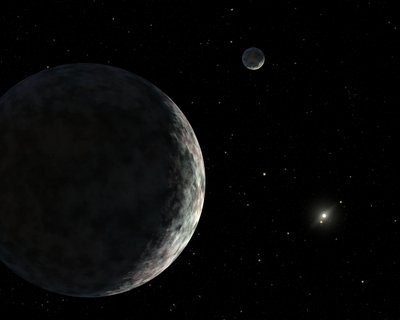The diameter of the moon known as Gabrielle (after Xena's kidney-bearing friend from the TV series) is one tenth of Xena's diameter (about 2,700 km - Pluto's diameter is 2,274 km)

By: Michal Levinstein, Israeli Astronomical Society
The tenth planet discovered - 2003 UB313 - looks more and more like the main players in the solar system. It has the weight of a normal planet (estimated to be 20% larger than that of Pluto), a catchy name - Xena (after the star of the TV series Xena the Warrior Princess) and its own Guinness record - a distance of 97 astronomical units or 9 billion miles from the Sun (the object the most distant in the solar system). And now astronomers from the California Institute of Technology and their colleagues have discovered that it also has a moon.
The moon - 100 times paler than Zina - orbits the planet every few weeks. It was discovered on 10/9/05 using the Keck II telescope from the WM Keck Observatory in Hawaii by Prof. of Planetary Astronomy Michael E. Brown Michael E. Brown and his colleagues from Caltech, the Keck Observatory, Yale University, and the Gemini Observatory in Hawaii. The research was partially funded by NASA.
"From the day we discovered Xena, the big question was whether she had a moon," says Brown. "Having a moon is 'racial' and respectable planets have their own moons - it's good to see that this planet has its own moon."
Brown estimates that the diameter of the moon known as Gabrielle (after Xena's kidney-bearing friend from the TV series) is one-tenth of Xena's diameter (about 2,700 km - Pluto's diameter is 2,274 km).
To know Gabriel's size accurately, the researchers need to know its composition - which has not yet been determined. Most of the objects in the Kuiper Belt, which extends beyond Neptune to the fringes of the Solar System, are made of half rock and half water ice. Since a surface made of both rock and water ice reflects an expected amount of sunlight - a general estimate of its size can be made. In any case - objects that are mostly made of ice reflect a large amount of light (brighter) and therefore can be depicted as larger than objects of the same size that are mostly made of rock.
Additional observations of the moon by the Hubble Space Telescope are planned for November and December. They will allow Brown and his colleagues to precisely pin Gabriel's orbit around Xena. Using this data they will be able to calculate the mass of Xena using a formula developed already 300 years ago by Isaac Newton.
"The combination between the moon's orbit around the planet and its speed around the planet tells precisely what the mass of the planet is," says Brown. "If the planet is particularly massive - the moon will revolve around it very quickly. If it is less massive - the moon will rotate around it more slowly. This is the only way we can measure the mass of Xena, since it has a moon.”
The researchers discovered the Gabriel moon using a new Laser Guide Star Adaptive Optics system equipped with the Keck II telescope. Adaptive Optics is a technique that removes the blur from atmospheric turbulence and creates sharp images like those obtained from a telescope placed in space. The Laser Guide Star System makes it possible to create an artificial "sun" by bouncing a laser beam 75 miles above the ground. Bright windows located near the object you want to check are used as Reference Points for corrections in the Adaptive Optics system. Since there are no bright suns near Xena, the system will not be able to work without this simulation (the artificial suns).
"With this system, the observers will not only get a higher resolution, but also a better concentration of light from pale light sources in the sky - and thereby discover pale objects" says Marcos van Dam - system technician at the Keck Observatory.
The new method allowed Brown and his team last January to observe the moon of 2003 EL61 known as "Santa" - a new large object discovered in the Kuiper belt. In contrast, no moon was discovered around 2005 FY9, known as the "Easter Bunny" - the third largest object discovered by Brown and his team using the 48-inch telescope at the Samuel Oschin Telescope at the Palomar Observatory.
The presence of moons around 3 large Kuiper belt objects - Xena, Santa and Pluto - challenges the conventional ideas of how worlds around the solar system got their own satellites. Until now, researchers have believed that objects in the Kuiper belt get their moons by gravitational attraction. This idea seemed to hold true for small inhabitants in the Kuiper belt, but not for Pluto. Pluto's massive moon - Charon - was formed as a result of a part of Pluto breaking off due to a collision with another object billions of years ago. The Xena and Santa moons may have originated from similar events.
"Pluto was considered a unique and strange object on the edge of the solar system," says Brown, "but now we see that it and Xena belong to a diverse family of large objects - with similar properties, history, and moons - that teach us more about the solar system than one strange object ever will."
